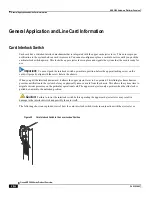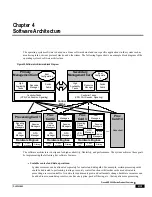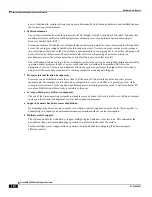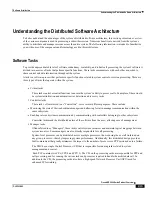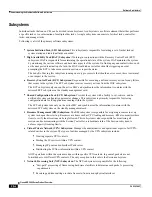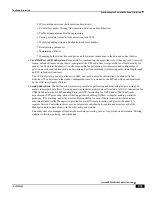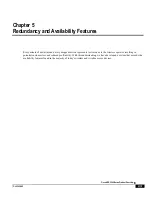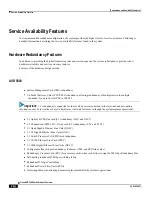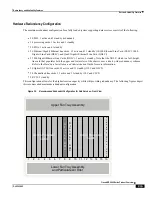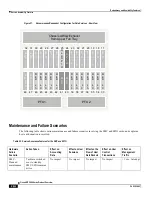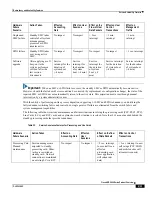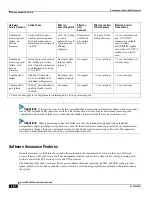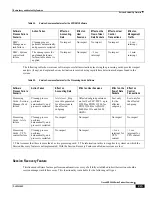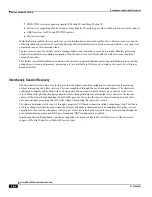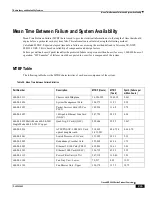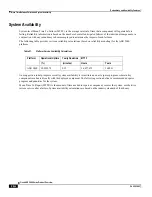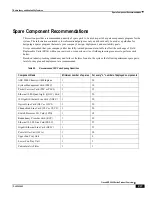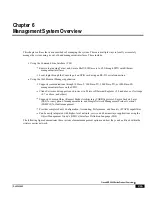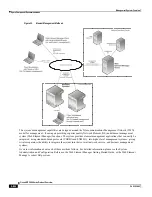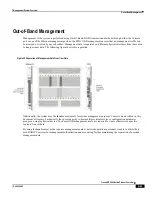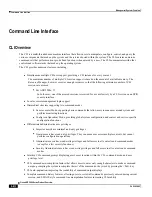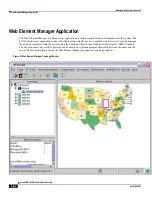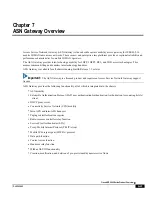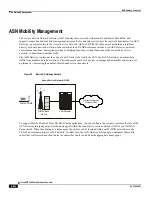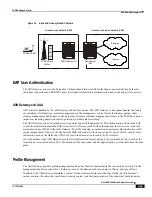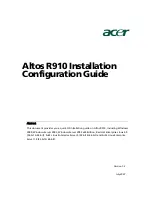
Redundancy and Availability Features
▀ Service Availability Features
▄ Cisco ASR 5000 Series Product Overview
OL-22938-02
PDSN PDIF services supporting simple IP, Mobile IP, and Proxy Mobile IP
HA services supporting Mobile IP and/or Proxy Mobile IP session types with or without per-user Layer 3 tunnels
GGSN services for IPv4 and PPP PDP contexts
LNS session types
With this feature enabled, there is no loss of session information as described in table above. Session recovery consists
of the migration and recreation of control and data packet state information, subscriber session statistics, or session time
parameters such as idle timer and others.
Typical recovery time for a single session manager failure is not expected to exceed 10 seconds. Should a processing
card hardware failure occur during a migration, then the time to recover all tasks and subscriber sessions should not
exceed 60 seconds.
This feature is enabled/disabled on a chassis-wide basis and requires additional processing card hardware to ensure that
enough reserve resources (memory, processing, etc.) are available to fully recover session in the event of a software or
hardware failure.
Interchassis Session Recovery
The Interchassis Session Recovery feature provides the highest possible availability for continuous call processing
without interrupting subscriber services. This is accomplished through the use of redundant chassis. The chassis are
configured as primary and backup with one being active and one inactive. Both chassis are connected to the AAA
server. When calls pass the checkpoint duration timer, checkpoint data is sent from the active chassis to the inactive
chassis. If the active chassis handling the call traffic goes out of service, the inactive chassis transitions to the active
state and continues processing the call traffic without interrupting the subscriber session.
The chassis determine which is active through a propriety TCP-based connection called a redundancy link. This link is
used to exchange status messages between the primary and backup chassis and must be maintained for proper system
operation. In the event the redundancy link goes out of service, interchassis session recovery is maintained through the
use of authentication probes and BGP peer monitoring. BGP routing must be enabled.
Interchassis Session Redundancy is currently supported on chassis configured for GGSN service or HA services in
support of Mobile IP and Proxy Mobile IP session types.
Содержание ASR 5000 Series
Страница 1: ......
Страница 26: ......
Страница 48: ...New In Release 10 0 SCM Features Cisco ASR 5000 Series Product Overview OL 22938 02 ...
Страница 50: ......
Страница 58: ......
Страница 67: ...Product Service and Feature Licenses Default Licenses Cisco ASR 5000 Series Product Overview OL 22938 02 ...
Страница 68: ......
Страница 126: ......
Страница 138: ......
Страница 146: ......
Страница 218: ......
Страница 236: ......
Страница 356: ......
Страница 374: ......
Страница 422: ......
Страница 496: ......
Страница 572: ......
Страница 654: ......
Страница 700: ......
Страница 726: ......
Страница 784: ......
Страница 816: ......
Страница 839: ...Network Address Translation Overview How NAT Works Cisco ASR 5000 Series Product Overview OL 22938 02 ...
Страница 841: ...Network Address Translation Overview How NAT Works Cisco ASR 5000 Series Product Overview OL 22938 02 ...
Страница 844: ......
Страница 906: ......
Страница 926: ......
Страница 942: ......
Страница 943: ...Cisco ASR 5000 Series Product Overview OL 22938 02 Chapter 30 Technical Specifications ...
Страница 966: ......
Страница 967: ...Cisco ASR 5000 Series Product Overview OL 22938 02 Chapter 31 Safety Electrical and Environmental Certifications ...
Страница 972: ......

